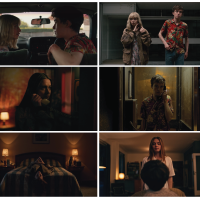New interview up over at Filmmaker Magazine with Nobody cinematographer Pawel Pogorzelski. Directed by Hardcore Henry stylist Ilya Naishuller, the film inverts the typical “man of violence coaxed back into action” formula. In your John Wicks or Takens, the middle-age protagonist suffers a transgression so grievous it demands brutal retribution. They don’t want to, but they have to. When Bob Odenkirk’s retired assassin Hutch is jarred from suburban drudgery in Nobody by a home break in, he loses only a few bucks, a kitty cat bracelet and some pride. Hardly a kidnapped daughter or a murdered puppy. Hutch doesn’t have to dust off his dormant aptitude for carnage….but he really, really wants to.
Pogorzelski opted for Red Helium cameras and Hawk V-Lite lenses for the film. Here’s the Polish-born, Canadian-raised cinematographer on his fondness for extensive preproduction testing:
Filmmaker: I’ve seen three films that you’ve shot and each used a different camera: Hereditary was Alexa, Midsommar was Panavision DXL2 and Nobody was Red Helium. What’s your process for choosing?
Pogorzelski: On every movie I do, I try to test every single camera I can get my hands on. For Nobody, I tested the Sony Venice, the Red Monstro and Helium, and the Alexa Mini and LF. We knew we wanted to do anamorphic, so on this movie so we tested a bunch of anamorphic lenses at Camtec in Hollywood.
Filmmaker: What are you actually shooting for those tests? Is it just a stand-in on a stool under different lighting conditions?
Pogorzelski: Usually I’ll have them walk around, maybe come in through a door so there’s movement through different contrasts and different spaces and I can see how each lens focuses. And for each lens, I’ll have them turn on a light that flares the camera so I can see the flares. It’s probably 20 seconds per lens, and that usually adds up to a 30-minute ordeal to watch everything with the director.
Filmmaker: It’s an ordeal? I guess 30 minutes of someone walking through the same space would be tedious.
Pogorzelski: It feels so long.
Filmmaker: And when you do that screening, it’s a blind test for the director, right? They don’t know which camera or lens they’re looking at.
Pogorzelski: Correct. We watch those tests, then choose which combination of lens and camera works best for the movie. When we’re shooting the tests I usually start to get some idea of what combination I’m going to like, but that’s from seeing it on a 17-inch monitor. As soon as I get to the big screen and watch it on the projector, it changes. It’s not a technical test, really. It’s very much an artistic test. I don’t remember, for example, why I chose the Alexa for Hereditary. It just worked for that movie.

And here’s Pogorzelski on Nobody’s first big action set piece, which pits a rusty Odenkirk against a pack of drunken Russian thugs on a city bus.
Filmmaker: You used a real bus for the scene. Did you have to add that strip of lights that goes around the top of the interior?
Pogorzelski: They were already there. We just took out the fluorescent bulbs that were in them and replaced them with Astera tubes. I wanted to be able to control the light so there was a key light on one side and fill on the other so it wasn’t all flat. So, I put dimmable Astera tubes the entire length of the bus and was able to control each section. Usually I made wherever Bob was on the bus a bit more intense by maybe half a stop and let everything else be a bit darker.
Filmmaker: You shot that scene on a real street rather than on stage. Did you have to swap out the practical bulbs for the streetlights and commercial building lights we see out the bus windows?
Pogorzelski: We did have to ask the city to turn off certain lights that we didn’t like and keep on the ones we did. Then, in the background, we just added a couple of bigger lights on condors to give a bit more sense of depth.
Filmmaker: That scene is largely handheld. I’m also guessing it was more single camera than the rest of the shoot just because of the limited space inside the bus. How much of that style was dictated by the restrictions of the space?
Pogorzelski: That was definitely mostly one camera. Maybe a few times we were able to work two cameras in there, but there was really no room. At first, actually, we were thinking of a different look for that scene and even did a rehearsal where we used dollies and jibs. Emotionally, it just didn’t feel right. This is the first burst of energy that Bob finally gets to release and when we went back to the handheld we were able to get the energy we wanted. Shooting handheld, we were also able to get closer with wider lenses, and that made it feel more like you were in the fight and part of the action.











